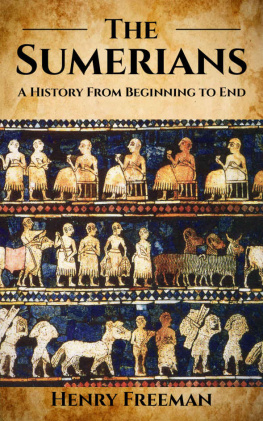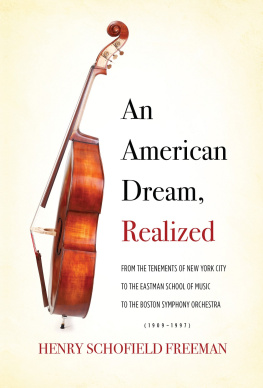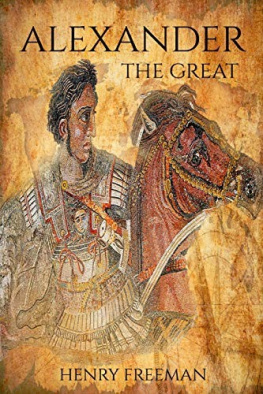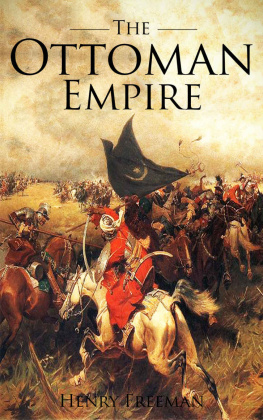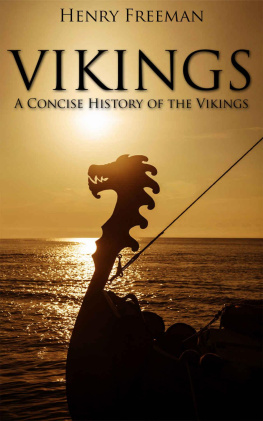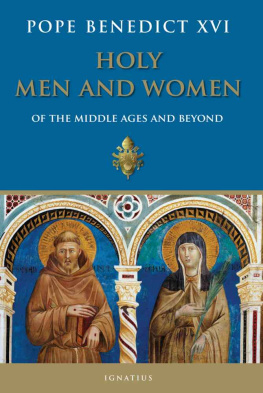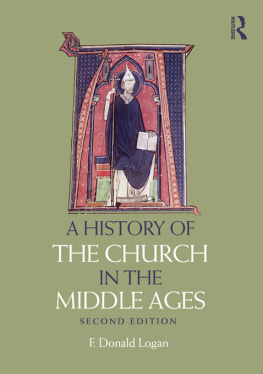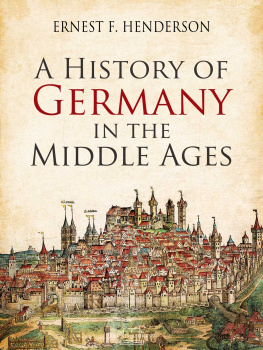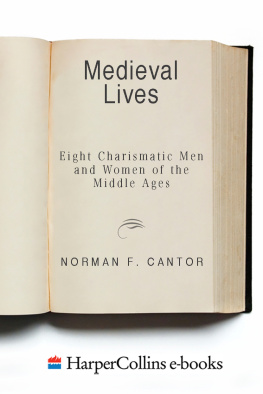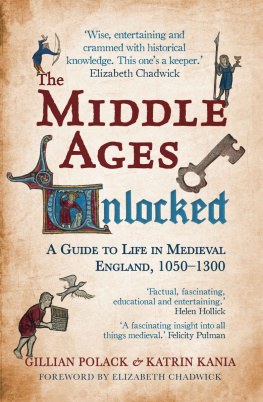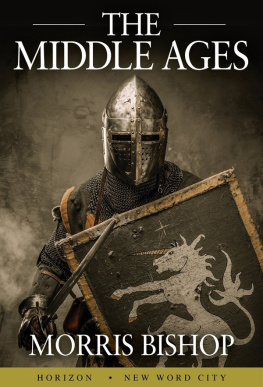THE MIDDLE AGES
A History From Beginning to End
Copyright 2016 by Hourly History.
All rights reserved.
Table of Contents
Chapter One
The Early Middle Ages
For too long, many people, including some scholars, saw these two periods of history as the seminal epochs in civilizations history. In between? Only the Middle Ages, a long interim period also known as the Dark Ages. However, historians are rethinking the significance of this time period stretching from 476 CE, when the Roman Empire in the West was reduced by vigorous barbarians to a glorious memory, and the outbreak of intellectual inspiration that led to a rebirth of art, creativity, and even national politics around the 14th century. Its true that the Renaissance was a glittering panoply of achievement, but that doesnt mean that the Middle Ages had nothing to bring to civilizations table: what about Charlemagne, Richard the Lionheart, Eleanor of Aquitaine, Magna Carta and the Peasants Revolt? What about Joan of Arc? The Black Death? Cathedrals with soaring architecture, illuminated manuscripts that inspired, literary legends that have endured all attest to the dynamic artistry, productivity, and significance of the era that is so much more than the centuries packed in between Romes fall and the Renaissances flowering.
This period of time is so shrouded in mystery that its often difficult to discern where truth ends and myth begins. It was during this time, somewhere in the fifth century, that historians believe that a warlord in England rallied his forces to protect against the Saxon invasion. In later centuries, the story of Arthur would be embellished into the legend of Camelot and the tales would inspire the courts, troubadours, and artists of the later Middle Ages. Some credit a Briton of Roman habits named Arcturus with inspiring his people in the fifth century into a sense of nationalism; others say there was a man of Welsh background who fought against the Saxons who had been invading and encroaching on English lands. Later, the brief, shining hour of legend was temporary; the Anglo-Saxons came to dominate the island until they, in turn, were defeated by the Scandinavian Vikings and later by the Normans. A great deal of cultural recycling took place during the Middle Ages as the hardy peoples built on and bettered what was at hand.
Some of the mystery is solved by what archeologists found in the Sutton Hoo burial site which dates from the sixth and early seventh centuries. The artefacts from the ship burial include a helmet, shield and sword, a lyre, a suite of metalwork dress fittings in gold and jewels, and silver plate. The grave tells much about these peoples and how they lived, and history is indebted to archeology for filling in some of the missing pieces. However, additional missing pieces remain, nonetheless.
Its not as if there was an immediate and abrupt schism between the time when Rome fell and the nations that theyd conquered were left to fend for themselves. The society of the Middle Ages was divided in three sectors: laborers, warriors, and clerics. Farmers continued to plant seeds and pray for a good harvest even as the prayers to the one God of the Christians replaced the many gods who had ruled over the elements. A local landowner who assumed the military responsibility for protecting his estate continued to do so, albeit without the overarching protection of Rome. The Christian Church, once it had won the hearts and souls of Europeans, would grow to be the entity that would provide spiritual solace, inspire the arts, and recruit for religious wars over the course of time. But first, the orphaned nations had to deal with the pains of growing up.
The Middle Ages are generally regarded as lasting from the fifth to the fifteenth century, although the latter date is more fluid depending on the country. However, the Middle Ages represent so complex a span of time that the centuries must be divided into separate eras in order for the times to correctly and accurately be analyzed.
The Early Middle Ages began in 476 with the fall of the Roman Empire and lasted until roughly 1000 CE, give or take a century here and there.
The High Middle Ages spanned the three centuries from 1000 to 1300.
The Late Middle Ages, the period that bordered the beginning of the Renaissance, started in 1300 and ended around 1450.
The Middle Ages were rooted in their Roman past, but what blossomed from the soil of the Empire, proved to be a bold and bright flower that would reveal humanity in such depth and nuance that it unleashed the power of mortal creativity to express it, even as its survival in the early years was precarious.
The End of the Empire
In 60 BCE, Julius Caesar began a period of conquest and power consolidation that would result in the creation of the mighty Roman Empire. Roman rule, extending from the British Isles, all of the Mediterranean region, northwestern Europe, the Near East, northern Africa, and Palestine, controlled a stretch of territory that today encompasses 48 countries. Roman roads were renowned for their efficiency and for their role in encouraging trade. The disciplined soldiers of the Roman legions were unbeatable; Roman law was supreme, and the fabled Pax Romana was a peace enforced by the knowledge of what Roman might was capable of doing. The Empire was an ethnic melting pot made up of every demographic from sophisticated Greeks to provincial Celts. In the West, Latin was the formal language; in the East, Greek. This would prove significant in the centuries to come in the West, when Latin retained its mastery.
Before the Empires demise, the dangers from that earlier Wild West were already becoming apparent. The Emperor Diocletian divided the Empire into two segments, the Eastern and Western Empires; Emperor Constantine took matters a dramatic step further when he made Constantinople in the East the capital of the Empire instead of Rome. Roman citizenship was no longer the hard-to-achieve symbol of belonging; full citizenship was granted to all the Empires subjects who were free. Although Rome imposed its laws upon subject nations, those nations were not expected to emulate Roman dress, food, or customs, so they retained their own identities. Those identities would become distinct after the Empire fell, and nations which had considered themselves part of Rome realized that they were on their own.
Despite the dominance of the Empire, there were enemies beyond the borders. Germanic tribes joined forces to attack the Empire and acquire territory. In 410, Alaric, king of the Visigoths, led a sack of Rome; in 455, it was the Vandals threatening the city. The Western Empire was vulnerable on its western borders. Huns, Goths, Visigoths, Picts, and Scots repeatedly hammered the boundaries. In order to protect its borders, Rome allowed some of its Germanic foes to settle Roman lands in exchange for maintaining the borders against other barbarian enemies. Vandals ruled Spain and the remaining Roman provinces in northern Africa; Ostrogoths were in Dalmatia, and Huns held power in Eastern Europe. The invaders took the axiom When in Rome, do like the Romans seriously. The Empire was glue for disparate tribes and peoples, even as they retained their own customs and languages. Everyone wanted to be Roman, and even the barbarianswhich meant anyone who wasnt Romanwho were hired to fight for Roman became Romans: the Visigoths in Spain, the Vandals in North Africa, the Ostrogoth in Italy; the Franks in France, the Angles, Saxons and Danes who settled in England. And they fought against the Huns who attacked Rome in 451.


